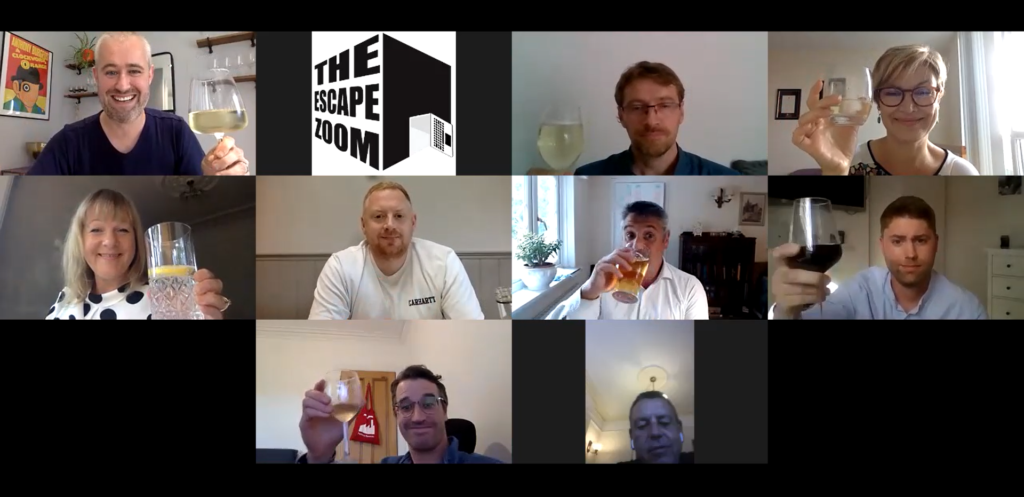Escape Zoom 6: How can brands navigate the ecommerce and retail trends accelerated by lockdown?


The retail industry is constantly being shaped and then reshaped by technology. Innovators set a new standard for consumers, and incumbents rise to meet it, or disappear altogether.
These cyclical changes usually happen over years. However, the COVID-19 pandemic has slammed a heavy foot on the accelerator of this process and the market is changing at an unprecedented rate.
In our sixth Escape Zoom session, Propeller’s Director of Media, Business Development & Partnerships, Ben Titchmarsh and Group Director, Clients & Strategy, Rose Bentley, gathered experts from across the sector to discuss how brands can navigate through this rapidly shifting landscape. Participants in this session included:
Andy Mulcahy, Strategy and Insight Director at IMRG
Robert Nowell, Marketing Director (Global) at Edge by Ascential
Helen Slaven, Chief Revenue Officer at Poq
Aron Cody-Boutcher, Founder at The Framework Forge
Richard Kelly, CEO, Adimo
Andy Hicketts, Senior Vice President Business Development, Endava
James Mansfield, Founder, Field&Flower
Andy Mulcahy, Strategy and Insight Director at IMRG
Most of us can see right now that the high street is not in a good place. To be honest, it wasn’t in a good place ten years ago. It is haemorrhaging money and jobs – but this is all a consequence of it not knowing really what it is – or who it’s for.
2019 wasn’t a good year for retail. We tracked over £23bn in sales across 210 retailers – and it would’ve been a year of marginal growth if not for an exceptional Black Friday and strong Christmas.
We are seeing a growth rate online which we haven’t seen since 2008, when it was a far less mature market. We’re seeing growth in almost every category – apart from clothing and footwear! Each category has its own internal variations that reflect the context of our lives – for example, Electricals are doing well but nobody is buying an iron. More than ever before, retailers need to have a firm finger on the pulse of consumer demand.
Our data shows that it is the hybrid retailers with online and offline channels that are doing the best – up around 40% – while online only retailers are up about 10%. Interestingly, we saw that when physical shops re-opened, there was a significant sales spike online.
Footfall in stores is massively down – but we can see that when a consumer enters a store, they are on a mission, and the conversion rate is probably close to 100%. The next phase will be identifying a new pattern of demand from consumers and understanding their shopping habits.
“The over 65’s is now the fastest growing demographic for online. We are seeing – amongst this group in particular – that the hesitation or resistance to learning how to use digital is less than the current fear of going out or into a store.” - Helen Slaven
Aron Cody-Boutcher, Founder at The Framework Forge
I worked on a post-mortem for Laura Ashley and Jack Wills and some of the recent highstreet failures – all of these retailers were sat on a decade of brand search decline. These brands didn’t develop their product range or their relationship with audiences. On top of this, you can clearly see financial structural problems which were immediately exposed by COVID-19.
It is worth UK businesses looking at the impact of SARS on Asia. China and Japan have both seen similar patterns following health crises – in the short term online orders spiked and things like automotive sales dropped off a cliff. But then after a while people realise they don’t want to take a bus anymore – so they buy that new car. Over time we tend to see markets and people revert to the norm.
Robert Nowell, Marketing Director (Global) at Edge by Ascential
We recently conducted a session with a major consultancy looking at how the crisis has affected CPG brands. The first thing we can see is that for CPG brands, there is much more planning needed. Ten years ago, reporting would’ve been quarterly or seasonal – but now it is almost weekly.
Secondly, there is a keen focus on individual SKUs. We’ve seen some interesting dynamics – as Andy noted – some home appliances are through the roof and others can’t be sold for love nor money.
The third trend is that there is clear and urgent need for instantly available data. As opposed to looking at quarterly strategy reviews, brands and retailers need to be able to react quickly and mould their strategy based on a live-stream of information.
Helen Slaven, Chief Revenue Officer at Poq
The over 65’s is now the fastest growing demographic for online. We are seeing – amongst this group in particular – that the hesitation or resistance to learning how to use digital is less than the current fear of going out or into a store.
At Poq, as we’re solely focused on app-commerce, we often get challenged with mobile shopping as only being of interest to a younger customer base. But we’re seeing a much more even spread across demographics than we have seen before, and that is representative of the mobile channel now becoming the priority in any digital strategy.
We could see that downloads of our customer apps through the Poq platform spiked following lockdown – reaching levels previously only reserved for Black Friday. Our stats showed that for most retailers in the earlier stages of lockdown it became “Black Friday Every Day”. Across all our retail categories we saw better performance than many expected – even fast fashion customers, who quickly pivoted to loungewear categories to maintain their sales during the lockdown period.
We always knew that conversion on mobile apps was 3x stronger than on mobile web – and now we now know consumers are more confident to shop on apps than ever before.
Richard Kelly, CEO, Adimo
We’ve seen a clear shift in trends across the lockdown period. When the UK first stepped into lockdown, we saw a big spike overall in terms of engagement and baskets – but a lot of the growth focused on certain categories. The more essential the product, the bigger the spike.
Since then, we’ve seen trends normalise back to pre-COVID levels – but just at a bigger scale. Overall we are seeing a 4x increase in traffic and basket values. One of our key pieces of tech is shoppable recipes – so consumers can interact with a brand’s recipe and buy all the ingredients in a few clicks – and there has been massive growth here. It shows that people are at home and experimenting and engaging with food in a new way online.
Andy Hicketts, Senior Vice President Business Development, Endava
We’ve seen a big shift in the last three months. Initially, there was a lot of confusion about what projects would be going ahead – and many businesses were immediately preoccupied with sorting their employee strategy. Each sector has a very different perspective – but in eCommerce we saw it was almost business as usual.
James Mansfield, Founder, Field&Flower
Pre-lockdown, our marketing was very much about supporting and working with local farms – paying farmers more money and creating a sustainable food-chain. Tapping into this story through our marketing gives us an opportunity to tap into consumer’s desire to support local as well as differentiating us from the bigger competitors. This has become even more effective under lockdown.
In terms of seeing changes in demographics – as a small business our data-set is limited – but we are seeing that our customers are ordering our products for parents who live all around the country. So not the full digital transformation – but definitely progressive steps.
—
Much has been made of the ‘digital divide’ in markets like the UK – where younger generations are plugged in and online while older consumers are habitually linked to more traditional, analogue means of shopping. The health crisis stands to potentially flip this on it’s head: older people, who are generally more vulnerable to COVID complications, may seek to stay away from stores, while younger audiences, seeking escape from an overly-digital existence, may relish the experience of visiting a store.
Thanks to our guests for their contributions and insight – keep an eye on this page for more Escape Zoom content to follow.